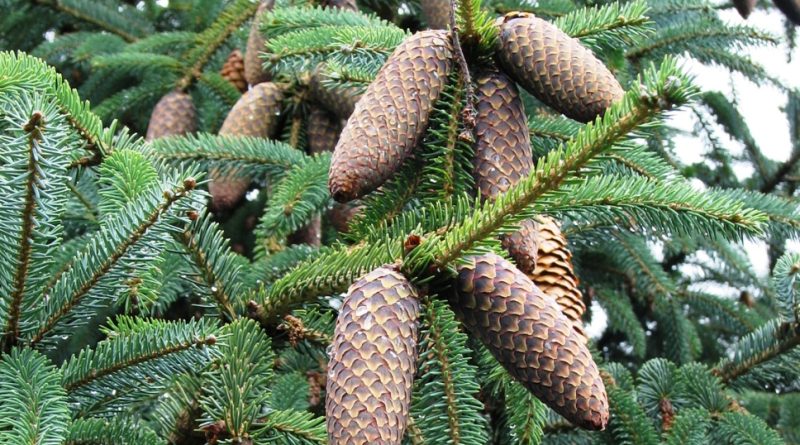Picea likiangensis
Picea likiangensis
The Lijiang yunshan spruce or Lakiang spruce, Lijiang yunshan (Picea likiangensis (Franch.) E. Pritz., 1900) is an arboreal species belonging to the Pinaceae family.
Systematics –
From a systematic point of view it belongs to:
Eukaryota domain,
Kingdom Plantae,
Pinophyta division,
Class Pinopsida,
Pinales Order,
Pinaceae family,
Genus Picea,
P. likiangensis species.
The term is basionym:
– Abies likiangensis Franch..
The term is synonymous:
– Picea balfouriana f. bicolor ShanCheng.
Four varieties are recognized within this species:
– Picea likiangensis var. hirtella (Rehd. & E.H.Wilson) W.C.Cheng;
– Picea likiangensis var. likiangensis;
– Picea likiangensis var. montigena (Mast.) W.C.Cheng;
– Picea likiangensis var. rubescens Rehd. & E.H.Wilson.
Etymology –
The term Picea comes from picea, the Latin name of the wild pine in Virgil and Pliny.
The specific epithet likiangensis refers to the Lijiang Shan, a mountain massif in the prefecture of Lijiang, an area where the species was found and collected by Delavay for the first time (Franchet 1899).
Geographic Distribution and Habitat –
The Picea likiangensis is a conifer native to an area that includes Bhutan; China (South Qinghai, South and West Sichuan, East Xizang (Tibet), North West Yunnan, at 2500-4100 m altitude.
Its natural habitat is mountain valleys, such as in the vicinity of Kangding, Sichuan, where specimens of several varieties are found first collected by E.H. Wilson (Faryon 1990).
Description –
Picea likiangensis is a conifer that grows up to 50 meters in height, with a pyramidal or conical crown.
The trunk is monopodial and straight, which can reach 2-2.6 m in diameter.
The bark is rough and grooved, gray in colour, with recently exposed parts an orange-brown colour.
The branches of the first order are long, slender and with an ascending habit. The second order branches are variable, non-drooping.
The shoots are thick, stiff or slender, initially yellowish-gray or orange-brown, then reddish-brown, furrowed and finely wrinkled, glabrous or pubescent; the pulvini are 1-1.5 mm long, arranged at 60°-90°.
The leaves are needle-like, dark green or bluish-green on the upper page, glaucous below, rigid, linear, straight or curved, with a square-rhombic section, 0,8-1,5 cm long, with acute and prickly tips; they have stomata on both sides, arranged in a few lines. The vegetative buds are ovoid-conical or conical, 4-6 mm long, slightly resinous; they have small, triangular, red-brown or purplish-brown pearls, which persist for years.
The male cones are initially pink-red, then yellowish when ripe, axillary, 2-2,5 cm long.
The female cones are sessile or with short peduncle, oval-oblong, initially erect, then hanging when ripe, 7-12 cm long and 3,5-5 cm broad, initially red or magenta, then yellowish-brown or reddish, brown -Purple or pale brown when ripe, with blunt tips and oblique base. The macrosporophylls are small, obovate, 1.5-2.6 cm long, with a smooth or striated, glabrous abaxial surface. The bracts are small, ligulate, 2 mm long, entirely included.
The seeds are dark brown, are ovoid-conical, 2-4 mm long, with a winged part of a light brown colour, ovate-oblong, 7-14 mm long.
Cultivation –
Picea likiangensis is a plant that grows in an area between 2500 and 4100 meters above sea level. and which has a cold hardiness limit between -12.1°C and -6.7°C.
For its cultivation it must therefore be in areas with climates that respect these conditions.
This conifer is widespread in Europe and North America as an ornamental tree in private gardens and botanical gardens.
Propagation is by seed.
Customs and Traditions –
Picea likiangensis is a conifer whose wood is used in the paper industry, in construction, for the production of poles and furniture; tannin is obtained from the bark, aromatic oils are obtained from the leaves and resin is distilled from the wood.
Regarding its conservation status, the levels of exploitation of both the tree and the forest in general have caused a decline in population. There are no signs of pressure relief and no protective measures are applied. The tree, as noted, provides useful timber and levels of exploitation of both it and the forest in general have caused severe habitat fragmentation and population decline” (WCMC 1998).
Economic exploitation and the consequent deforestation has therefore caused a reduction in the population estimated at around 30% in the last 75 years; for which it is classified as a vulnerable species in the IUCN Red List.
Method of Preparation –
Picea likiangensis is a conifer whose wood and bark are used. The former is used in the paper industry, in construction, for the production of poles and furniture; the tannin is obtained from the bark.
Aromatic oils are extracted from the leaves and resin is distilled from the wood.
Guido Bissanti
Sources
– Acta Plantarum – Flora of the Italian Regions.
– Wikipedia, the free encyclopedia.
– GBIF, the Global Biodiversity Information Facility.
– Useful Tropical Plants Database.
– Conti F., Abbate G., Alessandrini A., Blasi C. (ed.), 2005. An annotated checklist of the Italian vascular flora, Palombi Editore.
– Pignatti S., 1982. Flora of Italy, Edagricole, Bologna.
– Treben M., 2000. Health from the Lord’s Pharmacy, Advice and experiences with medicinal herbs, Ennsthaler Editore.
Photo source:
– https://repo.rbge.org.uk/image_server.php?kind=1500&path_base64=L2l0ZW1faW1hZ2VzL2FjY2Vzc2lvbnMvMTkvMTEvMDAvNDAvUGhvdG9fNTA5MjU0M2U5YmJjMS5qcGc=
– https://plant.depo.msu.ru/open/public/item/MW0732160/img/0.jpg?gbif
Attention: The pharmaceutical applications and alimurgical uses are indicated for informational purposes only, they do not in any way represent a medical prescription; we therefore decline all responsibility for their use for curative, aesthetic or food purposes.


